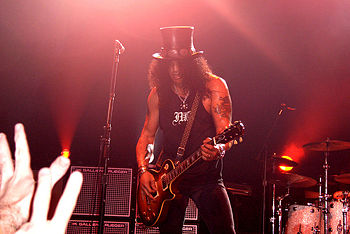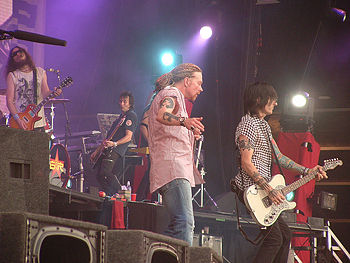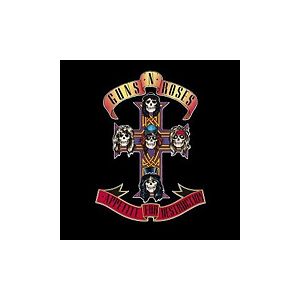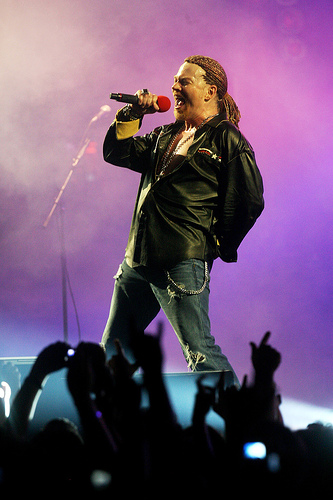Guns N' Roses
Guns N' Roses is an American Hard rock band from Los Angeles known for their gritty, sleazy, and hard-driving hard rock style. Their sleazy style is illustrated by their lyrical content, which describes liquor, sex, drugs, and city life. The band gained much popularity in the late 1980s with the release of their breakthrough album Appetite for Destruction, which featured the chart-topping hit "Sweet Child o' Mine".
Origins
Guns N' Roses sprung out of the L.A. underground in 1985 after it was formed by the members of two separate hair metal bands: guitarist Tracii Guns, bassist Ole Beich, and drummer Rob Gardner of L.A. Guns and singer Axl Rose and rhythm guitarist Izzy Stradlin of Hollywood Rose. Rose had been a former singer of L.A. Guns for a short time before quitting to form Hollywood Rose. Beich later left the band and was replaced by Duff McKagan. Their first performance with their original line up took place on March 26th, 1985 at The Troubadour in Los Angeles with a flyer that read "L.A Guns and Hollywood Rose presents the band Guns N' Roses". After Guns left the band to attempt to reform L.A. Guns, the band hired a new guitarist: Slash. Slash had been previously acquainted with both Rose and Stradlin before joining the band. Steven Adler was hired as a new drummer and the band now had it's first stable line-up.
Early years and breakthrough album
Guns N' Roses released their first extended play album in 1986, dubbed Live?!*@ Like A Suicide under "independedent label" Uzi Suicide. The record contained four songs: two covers of Rose Tattoo's "Nice Boys" and Aerosmith's "Mama Kin", the hard-driving punk of "Reckless Life" and the rock n' roll of "Move to the City". The EP had the sound of a live album, but was actually a studio recording with a live audience overdubbed. Says Rose: "It ain't a live record-if you think it is you're crazy. What we did was go into a room, record ourselves and put 50,000 screaming people on top." [1]
Only 10,000 vinyl copies of the album were produced, but this EP led to a contract with Geffen Records and the release of their first and most famous album: Appetite for Destruction. The album brought about a new sound that reinvented hard rock. The rhythm section of Duff McKagan and Steven Adler played furiously under the heavy guitar riffs of Slash and Izzy Stradlin, while Axl Rose defined the band with his punk/metal influenced wails. The high-energy riffs of songs such as "Welcome to the Jungle" and "It's So Easy", the catchy boogie of "Mr. Brownstone", a song about heroin addicts, and Axl' s love-hate song to a prostitute; "Rocket Queen", defined Guns N' Roses as one of the greatest songwriters of the era.
The massive power ballad "Sweet Child o' Mine", Axl's love song to Erin Everly [2], became their breakthrough hit. After Appetite had not been selling well for over a year, MTV began putting the video of the song in heavy rotation and both the single and album instantly shot into the top ten. "Welcome to the Jungle" was re-released and also became a top-ten hit. The anthemic "Paradise City" soon followed. Guns N' Roses soon became one of the biggest bands in the world.
Their innovative music had influence from artists farther back than many thought. These included Rod Stewart's early Seventies band the Faces and the Keith Richards and Mick Taylor guitar combo of The Rolling Stones, that greatly influenced the duo of Izzy Stradlin and Slash. Nazareth also influenced Axl's singing style greatly.
After several tours across the country with the likes of bands such as Motley Crue, The Cult, and Aeromsith in 1988, they released their second album, G N' R Lies, at the end of the year. The album was a double EP that featured four new acoustic based songs (including the top-five hit "Patience") and a re-release of Live?!@* Like a Suicide!. Among these acoustic songs was the jokey murder ballad "Used to Love Her" and the albums closer, "One In a Million", which sparked much controversy among the press. The song featured Rose slipping into bigotry, misogyny, and violence; insulting every minority from homosexuals to blacks to immigrants. African-American rockers Living Colour took their revenge on Axl when they played with Guns N' Roses on a tour opening for The Rolling Stones in 1989. Guitarist Vernon Reid publicly commented on the song during their performance. [3] Slash, the child of mixed-race parents, was understandably upset by the song, but more so at Axl himself: “I said I didn’t think it was very cool, but Axl gets very adamant... I don’t regret doing “One in A Million”, I just regret what we’ve been through because of it and the way people have perceived our personal feelings." [4]
G N' R Lies soared up the charts to number 2 in the United States to join the six million-selling Appetite in the Top Five. This made Guns N' Roses the first band in the 1980s to have two albums in the Top Five at the same time. Only five other bands have accomplished this feat.
Later years

Slash, former guitarist of Guns N' Roses, playing with his new band, Velvet Revolver.
Guns N' Roses began working on the follow-up album to Appetite for Destruction towards the end of 1990. The band fired Steven Adler after the band claimed that he was playing poorly due to a drug dependency. The record label soon became concerned as the recording sessions for the new album were plagued by reliability problems. “Steven is about as much a rock ‘n’ roll personality as you can get. All he lived for was sex, drugs and rock ‘n’ roll – in that order, maybe drugs, sex and rock ‘n’ roll. Then it was drugs and rock ‘n’ roll. Then it was just drugs," commented Slash about the loss of his friend. [5] Adam Maples of Sea Hags temporarily filled his place as drummer.
However, Matt Sorum became the answer to their prayers. The drummer for the British metal band The Cult, whom Guns N' Roses had previously toured with, Matt was discovered by Slash after he had been to the local Universal Amphitheater to see the band and put in a transfer bid for their drummer. A sixth member was also added to the band, keyboardist Dizzy Reed. After calling Axl for advice after being evicted from his home, he soon found himself with a new job. Sorum's drum solo soon became a live highlight after he had improvised it to get the band out of the corner.
After the long recording sessions, over thirty three-months after the release of G N' R Lies, the band had enough recorded material to release two seperate albums. Thus, Use Your Illusion became two double albums, a first in the industry. In the United States alone, pre-orders broke 4 million copies. Use Your Illusion I and Use Your Illusion II were released in September 1991. With nearly three hours of material, the album showcased an incredibly ambitious band with piano-balladry similar to that of Elton John, acoustic blues, horn sections, backup singers, and ten minute rock epics in addition to the full-throttle guitar-based heavy metal. Group authorship had been destroyed by interband tensions and Rose's songwriting overshadowed much of the band. Axl's minioperas similar in vein to Queen's "Bohemian Rhapsody" such as "November Rain" and "Don't Cry" astounded critics while Stradlin-written numbers such as "Dust n' Bones" became simple filler tracks. The feel of The Rolling Stones also came through in "Coma" and Bob Dylan in a cover of "Knockin' On Heaven's Door".
The albums arrived at Numbers 1 and 2 on the charts in Britain and in reverse order with Illusion II on top in the States. Both albums sold more in their first week than Metallica's self-titled album did in six. [5] It seemed as though the next decade would provide a large number of successful ventures for the band.
Decline
The release of Nirvana's Nevermind in 1992 brought about the beginning of a revolution of "alternative" rock and the hard rock of Guns N' Roses soon grew out of style as musical genres do. Rose became a tyrant, often spiraling into temper tantrums on stage and even inciting riots in Montreal while performing with metal band Metallica. [6] November of 1991 saw the departure of Izzy Stradlin from the band. Reported Stradlin: “After the gigs on the GN’R tour I was always taking off for the next gig. I wasn’t so much into hanging around on the last tour. I had to keep moving. On most of the legs, what I’d do was just roll out after the gig, sleep overnight if we were driving by bus, get up the next day and get out. Since day one I’ve always liked getting up early to see that is going on, because at least you get some memories of the places you’ve seen. It’s too easy to check into the hotel, raid the mini-bar, drink that up and then pass out.” [5] Stradlin's departure hit directly at the heart of the band. After losing their best songwriter, the band replaced him with Gilby Clarke of Kills for Thrills.
Finally able to shift to the new scene in hard rock, Guns N' Roses released The Spaghetti Incident?, an album that consisted of various covers of punk, glam, and soul songs, in 1993 to mixed reviews. What seemed like a return the shredding rock of their roots was plagued by Rose's growing interest in industrial music and electronica. His new musical direction split him from the rest of his bandmates, who were pointed in a more Rolling Stones direction. The band was put on hiatus without ever officially disbanding. For several more years the band remained quiet until Slash released the LP It's Five O'Clock Somewhere under his new side-project Slash's Snakepit in 1995.
Axl remained secluded in his studio all the while, recruiting musicians such as Dave Navarro, Tommy Stinson, and Robin Finck for jam sessions. Clarke was also kicked out of the band during this time and the remaining members became infuriated with Rose for replacing him with childhood friend Paul Huge. Rose also excluded Stardlin and Clarke from ever rejoining the band. A cover of The Rolling Stones' "Sympathy for the Devil" was the final straw for the now fledgling band after Rose cut out some of the band members contributions in the song and put Huge into the song. The band became furious with Rose for not consulting anyone about these changes. In 1996, Slash officially left Guns N' Roses and left Rose the only remaining member in the band's original line-up. Rose re-recorded Appetite for Destruction with a new line-up [7] as well as the song "Oh My God", which was featured in the Arnold Schwarzenegger film End of Days. But without a solid line-up, the last years of the decade seemed to be the end of the band.
The new Guns N' Roses
The year 2000 and the new decade would bring some fortune to Rose and his band. This year saw the addition of avant-garde guitarist Buckethead and ex-Nine Inch Nails guitarist Robin Finck. The band's line-up then consisted of Rose, guitarists Buckethead and Finck, bassist Tommy Stinson, ex-Primus drummer Brian "Brain" Mantia, guitarist Paul Huge, and keyboardist Dizzy Reed. 2001 also saw the band's first live performances in seven years at a New Years Eve 2000 concert in Las Vegas and at the Rock in Rio festival the month after. Appearing at the 2002 MTV Video Music Awards, some interest began set in on the new lineup, but when Rose stated in an interview that their new album would not be releasing any time soon, the new Guns N' Roses still did not garner the popularity they desired.
While touring in Europe and Asia, their first tour in nearly eight years, the band caused a violent and destructive riot in Vancouver, Canada after they had failed to show up for the first concert. [8] While Rose was failing to garner any popularity for Guns N' Roses, Scott Weiland (of Stone Temple Pilots-fame), Slash, Sorum, and McKagan formed the new band Velvet Revolver in 2002 to resounding success.
Many years past as fans eagerly waited for the new Guns N' Roses album, dubbed Chinese Democracy. Several session recordings were leaked and eventually found their way to internet file-sharing websites. The upcoming album put a heavy toll on Axl on the financial side of things. The still unreleased album, which Rose starting work on in 1994, has racked up production costs of over 13 million dollars. [9]. Producers Mike Clink, Youth, Sean Beavan, and Roy Thomas Baker have all been involved with the album in some way. In 2006 Rose began making appearances stating that the album would be released by the end of the year. Guitarist Ron "Bumblefoot" Thal was also hired to replace Buckethead.
Awards and Recognition
1988: Best New Artist, MTV Video Music Awards: "Welcome to the Jungle"
1989: Favorite Pop/Rock Single, American Music Awards: "Sweet Child o' Mine"
1989: Best Metal Video, MTV Video Music Awards: "Sweet Child o' Mine"
1990: Favorite Heavy Metal/Hard Rock Artist, American Music Awards
1990: Favorite Heavy Metal/Hard Rock Album, American Music Awards: Appetite for Destruction
1992: Favorite Heavy Metal/Hard Rock Artist, American Music Awards
1992: Video Vanguard, MTV Video Music Awards
1992: Best Cinematography, MTV Video Music Awards: "November Rain"
1993: Best Selling Hard Rock Artist, World Music Awards
Discography
- Appetite for Destruction (Geffen, 1987)
- G N' R Lies (Geffen, 1988)
- Use Your Illusion I (Geffen, 1991)
- Use Your Illusion II (Geffen, 1991)
- The Spaghetti Incident (Geffen, 1993)
- Chinese Democracy (Geffen, 2008)
Bibliography
- Mich St. Michael, Guns N' Roses, Magna Books, 1993.
- Slash, Saul Hudson, Anthony Bozza, Slash: The Autobiography, HarperCollins Publishers Limited, 2007, ISBN 0007257767
- Daniel Sugarman, Danny Sugarman, Appetite for Destruction: The Days of Guns N' Roses, Arrow, 1992, ISBN 0099970503
- Mick Wall, Guns N' Roses, The Most Dangerous Band in the World, Hyperion, 1991, ISBN 0283060867
Notes
- ↑ "Live?!@* Like a Suicide". GnResource.
- ↑ Bozza, Anthony, & Slash (2007). Slash. Harper Entertainment: New York. pp. 153-154
- ↑ Just a Little Patience, Spin Magazine (1999).
- ↑ "Slash: The Rolling Stone interview" Jeffrey Ressner with Lonn M. Friend, Rolling Stone, February 1991
- ↑ 5.0 5.1 5.2 Michael, Mich St., Guns N' Roses, Magna Books, 1993.
- ↑ Riot Erupts at Concert Starring Guns 'n' Roses, New York Times (11-08-92).
- ↑ "An Interview With Kurt Loder". www.heretodaygonetohell.com (1999-11-03).
- ↑ "Fans Riot After Guns N' Roses Tour Kickoff Canceled", Loder, Kurt. MTV News, (11-08-2002)
- ↑ "The Most Expensive Album Never Made", Leeds, Jeff. New York Times, (3-06-2005)


